
‘You need to know a little bit of almost everything’: Navigating the different disciplines of engineering
Michigan State’s Independent Voice
what does it mean to be an engineer?
Animal science sophomore Sophia Yabut poses for a portrait inside Michigan State University’s STEM building on
26.
Photo by Devin Anderson-Torrez
@THESNEWSTUESDAY, SEPTEMBER 27, 2022 STATENEWS.COM
CAMPUS For student athletes studying STEM fields, the challenge is even more difficult due to the demand of a heavy workload. “I just want to have the same opportunities that a white person would have,” animal science sophomore Sophia Yabut said. PAGES 6 SPORTS ‘It’s not easy’: Student athletes discuss life as STEM majors PAGE 7 CULTURE Minorities in STEM: Stereotypes, obstacles, success stories PAGE 4
LOOKING FORWARD THE FUTURE OF STEM With so many paths and focuses,
Sept.


TUESDAY, SEPTEMBER 27, 2022THE STATE NEWS2 PUREOPTIONS.COM 517-253-7602 FOLLOW US ON SOCIAL MEDIA @PUREOPTIONSCANNABIS @PROGROMICHIGAN 125 N CLIPPERT ST, LANSING, MI 48912
EDITOR-IN-CHIEF
Overall
EDITOR
EDITOR
CONTACT THE STATE NEWS
(517) 295-1680
NEWSROOM/CORRECTIONS (517) 295-5149
feedback@statenews.com
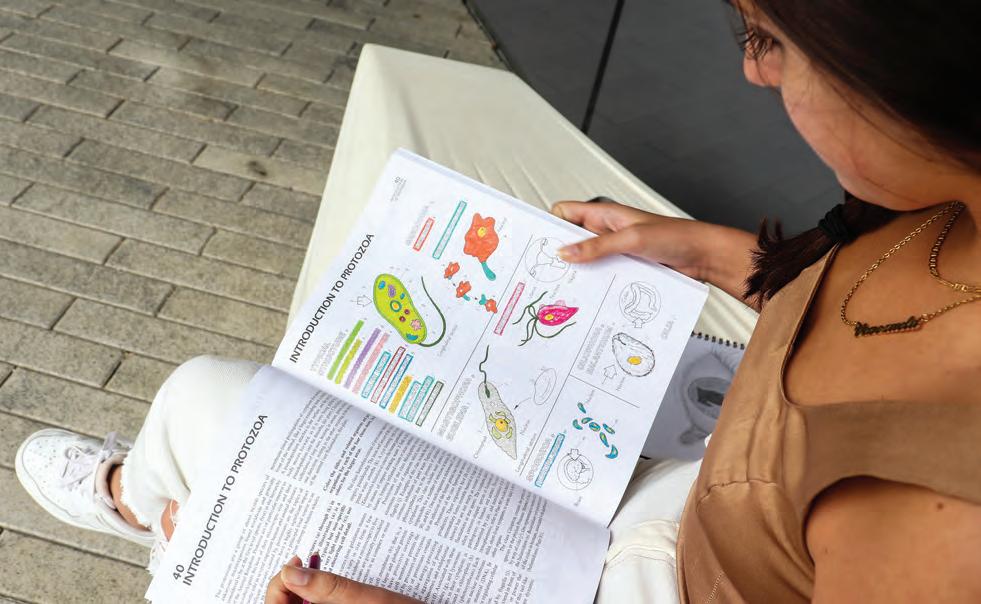
GENERAL MANAGER Christopher Richert
ADVERTISING
M-F, 9 a.m. to 5 p.m.
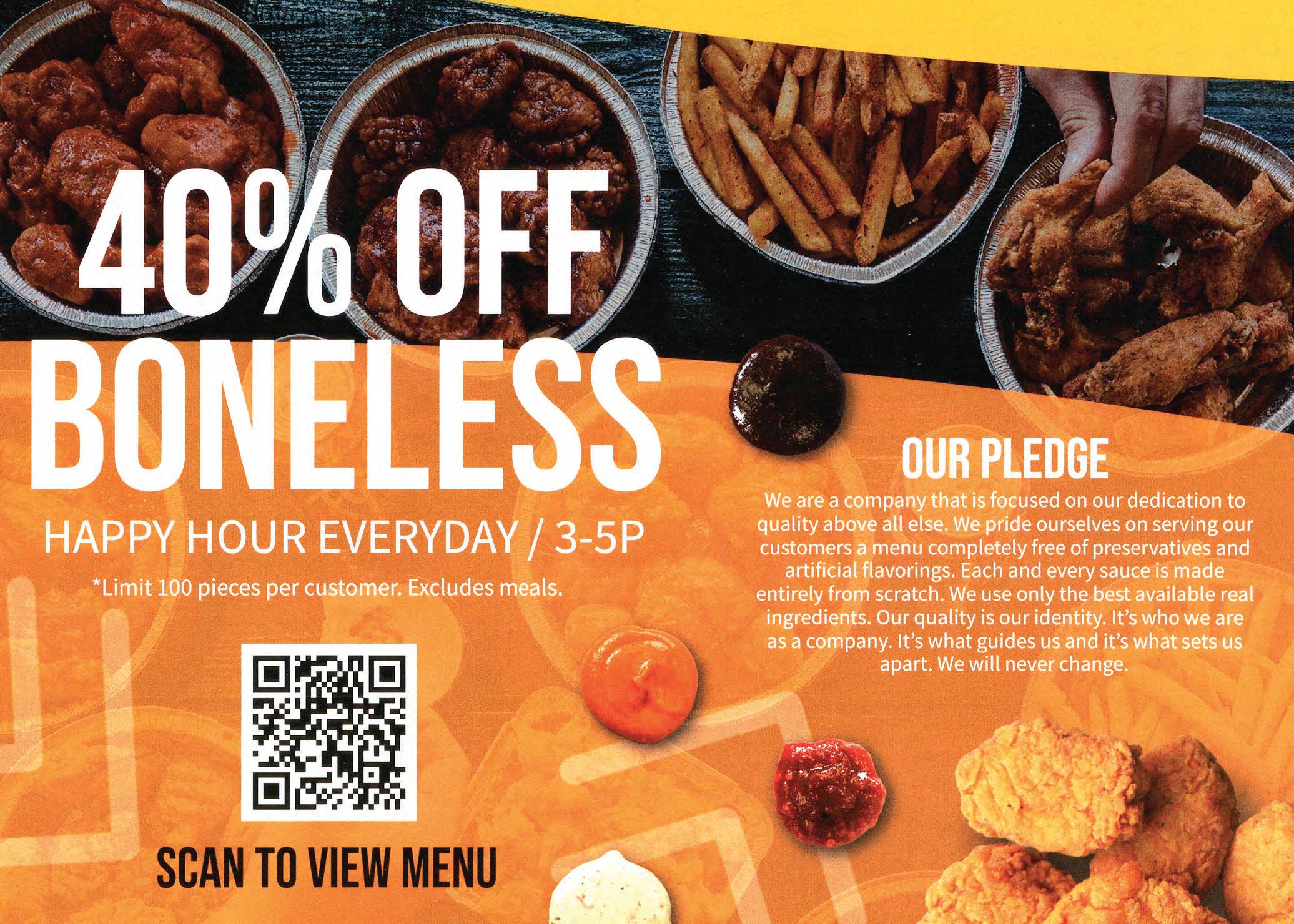
EDITOR
CHIEF
The State News is published by the students of Michigan State University every other Tuesday during the academic year. News is updated seven days a week at statenews.com. State News Inc. is a private, nonprofit corporation. Its current 990 tax form is available for review upon request at 435 E. Grand River Ave. during business hours.
SOCIAL MEDIA MANAGER

One copy of this newspaper is available free of charge to any member of the MSU community. Additional copies $0.75 at the business office only.
Copyright © 2022 State News Inc., East Lansing, Michigan
Microbiology junior Taryn Vielma colors in her microbiology coloring book outside of the Eli and Edythe Broad Art Museum on Sept. 20.
Photo by Sonya Barlow
3 Vol. 113 | No. 4TUESDAY, SEPTEMBER 27, 2022 STATENEWS.COMTUESDAY, SEPTEMBER 27, 2022FEEDBACK@STATENEWS.COM
SaMya
MANAGING
Dina Kaur CAMPUS
Morgan Womack CITY EDITOR Drew Goretzka CULTURE EDITOR Miranda Dunlap SPORTS
Sam Sklar COPY
Claire Grant MULTIMEDIA EDITORS Devin Anderson-Torrez Rahmya Trewern
Lauren Snyder DESIGN Madison Echlin Aryanna Dorsey
By Ashley Zhou and Dipika Rao azhou@statenews.com, drao@statenews.com
ISOLATION IN STEM FIELDS
For students like animal science sophomore Sophia Yabut, many of her extended family work in the STEM field as nurses, doctors or engineers.
Growing up, her parents didn’t mind what she studied, but she felt pressure from her extended family because they didn’t see non-STEM majors on the same level.
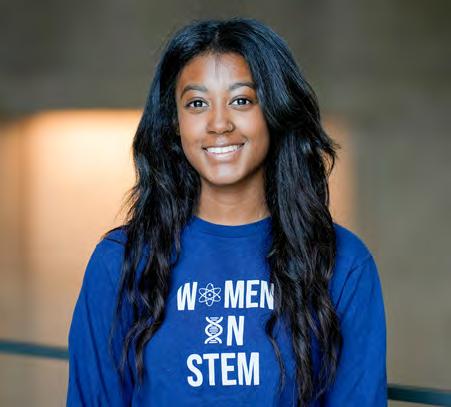
These experiences aren’t just limited to the classroom. Yabut, the only person of color on the Pre-Vet Medical Association’s, or PVMA’s, executive board, discussed the lack of diversity both in her field and executive board.
“It kind of takes a toll on me sometimes, because I feel like our leadership is not representing what veterinary medicine is entirely,” Yabut, a fundraising co-chair for PVMA, said.
Yabut said the majority of students in veterinary medicine are white. A times, she believes that she has to prove herself more.
“I don’t want to be discriminated against because I’m different from the majority of people in the field I’m going into,” Yabut said. “I just want to have the same opportunities that a white person would have.”
Coming from a first-generation student’s perspective, physics junior Jordyn Bradley felt some pressure to go to school with a degree that had more job security because her parents didn’t get that same opportunity.
Being a person of color in STEM, Bradley expressed similar sentiments, noting that such isolation can also serve as an internal drive.
“I do feel different from some of the other
people and e-board in general,” Bradley said. “But it actually makes me want to lead more because I know how important it is to have someone represent you that looks like you.”
As a Black student, Bradley worries she’ll have trouble gaining trust from her white colleagues because they may doubt her abilities. In her college classes, she’s also experienced microaggressions as a woman of color.
“There was one incident when I had difficulty with a section in my class, just reviewing the material,” Bradley said. “I was told I should just change my major to something easier and that I
could just go into a social science because that was more fitting for me.”
Computer science senior Clarence Nanamori, who is a Vietnamese American, felt similar stereotypical standards when compared to his peers.
“Growing up, I always had kind of a mild insecurity about that Asians have to be good at math because, frankly, I’m very average, I feel, when it comes to it,” Nanamori said.
Growing up and coming to MSU, Nanamori said he didn’t see many leaders or workers in higherlevel management that were people of color, and they were oftentimes overlooked when it came to those positions.
Similarly, human biology sophomore Ellen Kim feels the stereotype that “all Asians are smart” has excluded her from having basic conversations with other peers and adults.
“Whenever I meet someone and I introduce myself, … everyone I meet kind of just assumes that I am pre-med and that I have no problem,” Kim said. “(They assume) I’m not struggling with my coursework or I’m not struggling with other extracurriculars that I’m doing. They just assume I can do it … because I’m Asian.”
DRIVE TO MAKE A DIFFERENCE
However, for students like computer science senior Akhil Tatineni, who rushed Triangle Fraternity, a social STEM fraternity, being a minority hasn’t hindered him from leading as the rush and recruitment chair, he said.
“I just feel like it was a normal, everyday thing,” Tatineni said. “With this year’s program, we have been a very, very diverse field, more than we’ve ever had before, with people coming from many different countries.
Meanwhile, computer science sophomore Sidharth Rao used the stereotype to discover how he likes helping others.

Rao, who is an Indian American, has been asked by others for his homework countless times in high school but said he felt terrible when he didn’t have an answer. Now, he said he thinks it’s a good stereotype and tries his best to help those that ask.
For computer science sophomore Jennifer Lee, her career aspirations remain unaffected as a minority in STEM.
“I haven’t really gotten to work with a lot of white people so, I don’t think I was really discriminated against,” Lee, who is Korean American, said. “So maybe in the future … I will be, but I don’t think so because I feel … like this generation (has) a more positive outlook on minorities.”
Some students are genuinely passionate and strongly interested in STEM’s increasingly quick evolution. Due to this, possible discrimination doesn’t deter them.
“I have grown side-by-side (with) how technology has evolved throughout the years, and I think that has been a source of inspiration for me to study computer science,” computer science and math junior Gabriel Sotelo Justo said. “I think
it’s really empowering (for) people to achieve a lot through so little.”
Federal regulations make it more difficult for international students to find internships or jobs in the U.S. compared to domestic students.
However, Sotelo Justo, an international student from Peru, believes he was able to stand out with his accomplishments and achievements.
“I think I’ve been lucky enough to get internship offers,” Sotelo Justo said. “Even though it’s a concern for all international students, whether we can get a sponsorship or not, to stay or find a permanent job in the United States, … I have seen, at least from my perspective, it’s possible with effort and hard work.”
ADVICE FOR MINORITY STUDENTS IN STEM
For those that don’t have strong support systems, chemical engineering fifth-year Nathaniel Pascual recommends turning to some of the many student organizations that MSU offers.

“Reach out to groups that are doing work that are somewhat related to you,” Pascual said. “There are a bunch of groups that are able to provide that support for family members that aren’t able to provide.”
To stay connected to their culture and foster camaraderie, Yabut advises searching for student groups that align with their background and interests.
For international students, Sotelo Justo understands it’s daunting to come to a new country and leave everything behind, but said that hard work could make up for the unfairness and lack of opportunities in professional fields.
“There’s so many different builds of STEM and definitely see what would work for you and don’t get discouraged despite what other people may say,” Bradley said. “Or even if the classes are hard, you’ll find other students who can support you, no matter what.”
 Physics junior Jordyn Bradley poses for a portrait inside Michigan State University’s STEM building on Sept. 26. Photo by Devin Anderson-Torrez
Chemical engineering fifth-year Nathaniel Pascual poses for a portrait inside Michigan State University’s STEM building on Sept. 26. Photo by Devin Anderson-Torrez
Physics junior Jordyn Bradley poses for a portrait inside Michigan State University’s STEM building on Sept. 26. Photo by Devin Anderson-Torrez
Chemical engineering fifth-year Nathaniel Pascual poses for a portrait inside Michigan State University’s STEM building on Sept. 26. Photo by Devin Anderson-Torrez
“(They assume) I’m not struggling with my coursework or I’m not struggling with other extracurriculars that I’m doing. They just assume I can do it....because I’m Asian.”
Ellen Kim
Human biology sophomore
MINORITIES IN STEM: STEREOTYPES, OBSTACLES, SUCCESS STORIES
TUESDAY, SEPTEMBER 27, 2022THE STATE NEWS4 CULTURE 1. Open your MSUFCU account. 2. Make 10 debit card purchases. 3. Receive $100. msufcu.org | 517-333-2424 | Visit a branch Offer of $100 valid 5/1/22 to 10/31/22 for those who qualify under the MSU student SEG. MSUFCU account must be activated by 10/31/22 and 10 debit card purchases must post within 30 days of card activation to qualify. The $100 will be deposited into member’s checking account within 6 weeks of the 10th purchase. Not valid for existing members with an MSUFCU checking account. May not be combined with any other deposit offers. If new member is referred to the Credit Union, member referral offer will not apply. CLAIM YOUR $100 We CU SHOWING YOUR SPARTAN SPIRIT.
STEM majors balance artistic passions, academic pressures
By Alex Walters awalters@statenews.com
Human biology senior James Cozzi will graduate in December from Lyman Briggs College. He’s a senior pharmacy technician at Walgreens. He’s been shadowing an orthopedic surgeon since he was in high school and he’s currently awaiting decisions from a number of competitive medical schools.
However, he’s not all STEM. Cozzi is just one of the students at Michigan State University who balances studying STEM with an artistic passion.
Every Wednesday from 7 p.m. to 9 p.m., Cozzi is in rehearsal for MSU’s concert orchestra, where he’s the ensemble president. Cozzi played the violin for 11 years before coming to MSU. The opportunities for nonmajor musicians were a major draw in his college decision.
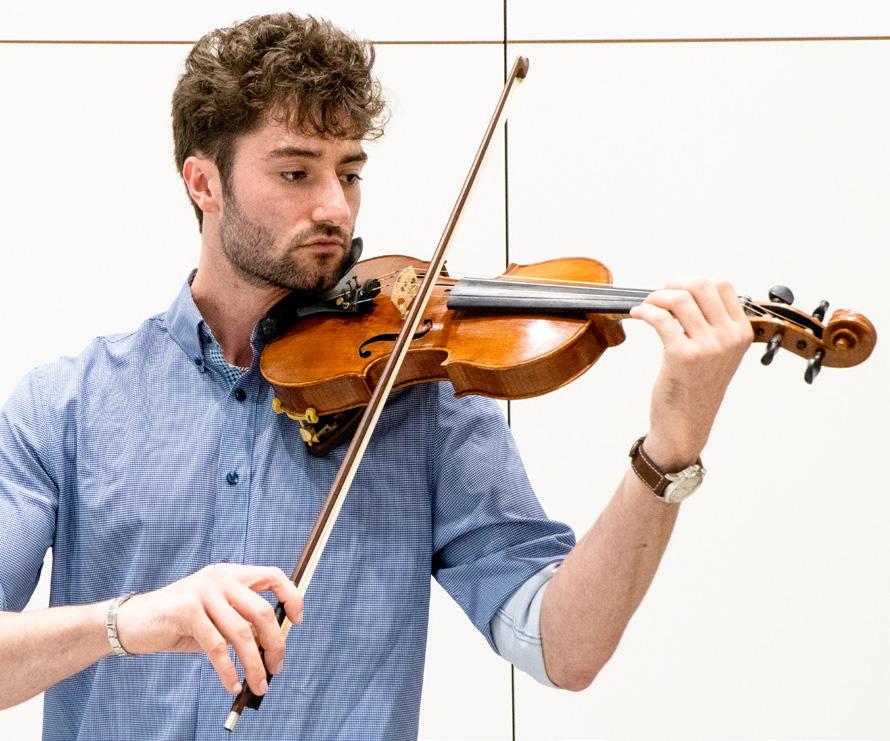
“I found out that Michigan State had started a new concert orchestra program that welcomes all musicians, regardless of major,” Cozzi said. “And that was the key thing, because a lot of universities
require you to be a music major to actually perform in an ensemble. ... With my aspirations of becoming a physician, I couldn’t fit that in.”
Some students said their studies and passions aren’t discrete parts of their lives. Instead, they enhance each other and balance each other out — their split interests have made them more well-rounded and capable in both STEM and the arts.
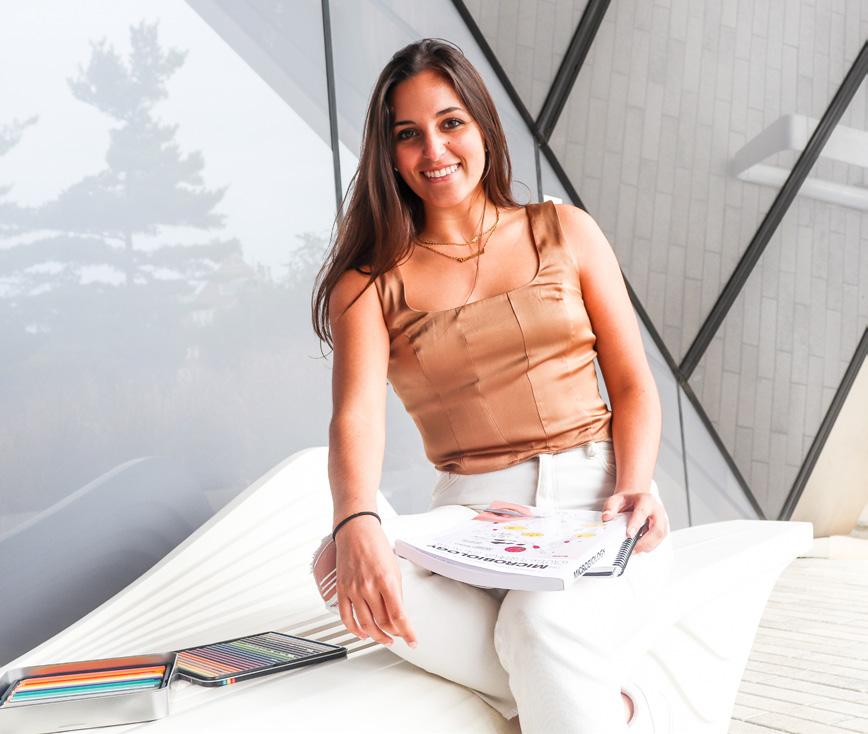
Cozzi said being in the orchestra teaches him to work collaboratively with his peers. He often has to communicate across the ensemble when he can’t speak verbally. He said this skill will be beneficial to his future in the medical field.
Microbiology junior Taryn Vielma is a visual artist. She said her art helps her understand scientific concepts and explain them to non-scientists in ways unartistic scientists could not.
“My family and my mom, they’re like ‘Your gift of art is really helping you when you’re studying and when you’re relaying information,’” Vielma said. “And when you’re presenting your research at conferences and everything like that, that
STEM students share their thoughts on stereotypes of themselves, other majors
By Hannah Woehrle hwoehrle@statenews.com
Out of the over 200 majors at Michigan State University, STEM programs are often seen as the most work-intensive of the bunch.
Human biology sophomore Anthony Mulhem said he finds himself spending five to six hours on homework a night. This is actually lower than average, he said, as his classes are still taking time to gear up for the semester.
“At the peak, it’s more like seven to eight because there’s just a lot more work to do,” Mulhem said. “Personally, for me, I need to really go over the material often, just so I can either memorize it or understand it really well.”
Environmental engineering senior
Joshua “JJ” Ringling said that while he was taking 17 or 18 credits of online classes during the COVID-19 pandemic, his workload looked similar.
Ringling said he thinks many STEM majors tend to be arrogant and cocky, and that a lot of them believe they are better than students with other majors – particularly business.
“There definitely are comments here and there about ‘Business isn’t a real major, you’re just here to party,’” Ringling said. “I tried to tend (to stay) away from that kind of behavior, personally. I mean, not to sound all high and mighty, but I would say the sentiment certainly is there amongst STEM majors.”
Political science-pre-law senior Brian Hough, who minors in data analytics, said there is a notable
visualization, you’re able to connect on a whole different level with people and make them understand.”
Hip-hop artist and computer engineering senior Timothy Boyd said balancing STEM and art has helped him in the opposite way. He believes the discipline he developed in his demanding major enables him to put adequate time into his art.
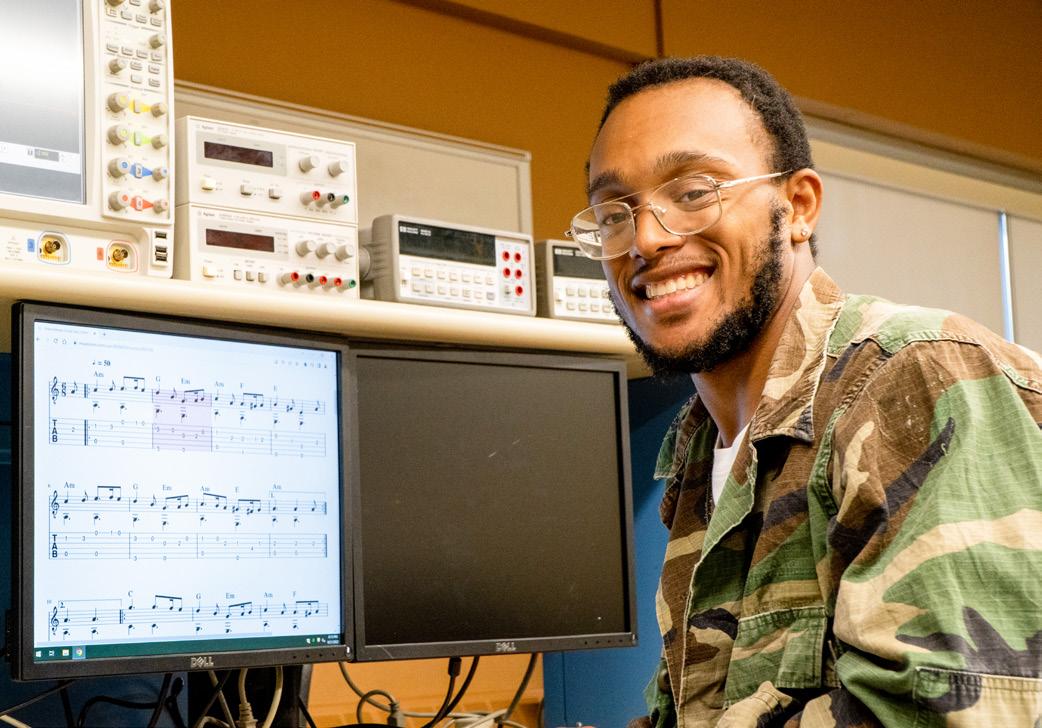
Boyd hopes to someday transition to making music full-time. He currently uploads his music to streaming platforms under the moniker “The Incredible Mind,” or “T.I.M.”
“That discipline of being able to work like I did throughout college, being able to wake up at seven and work until midnight, that type of work ethic is going to be needed,” Boyd said,
Other students see a simpler relationship between their art and their STEM major. Computer science senior Adam Anderson said having a low-pressure passion is a great release from the stress of rigorous studies.
Anderson spent his summer as an intern for Amazon and is involved
in an MSU research project that is creating an electronic delivery drone.
In the free time he has, he makes bedroom-pop music under the moniker “go:virgo.”
“I’m comfortable with them being two separate things,” Anderson said. “I think that’s better than them being intertwined.”
Anderson considered studying music as a guitar performance major, but now feels comfortable with his choice to study computer science as it takes the pressure off of music, preserving the serenity of his hobby.
Mechanical engineering junior Uma Pentakota took a break from her competitive dancing when she first came to MSU.
Now, she’s back to practicing art through the Nrityalaya School of Dance and encourages students putting off their passions, to jump back into them.
“If the person has a passion towards whatever art form they’re doing, I feel like you’ll always find your way back,” Pentakota said. “It comes down to being able to prioritize both.”
difference between his political science classes for his major and his STEM classes for his minor. While he said STEM classes are harder, there is also a difference in the attitudes of the students.
“It’s a breeding ground for God complexes for sure,” Hough said. “You’ve gathered a bunch of the people who have been deemed the smartest in their class for the past 10 or so years, and then you’ve told them all that they’re about the same and they should compete with each other.”
Neuroscience and psychology junior
Avi Bloch said another experience unique to STEM majors is people assuming your intelligence when you tell them about your program.
“People think automatically that I’m doing the hardest thing possible. Which simply that’s not necessarily true,” Bloch said. “There are some people (in neuroscience) who act a little bit more like they have more on their plate than they do. Or if not necessarily more on their plate, but they act as if they have the hardest job that the school could give them.”
While they aren’t the only ones at MSU that have entire buildings or sections of campus devoted to their major’s classes, Bloch said STEM majors do tend to be “cliquey” and he finds himself spending more time with people in his classes.
He said a reason for this is that the classes are difficult and group-based, making it the perfect environment for cliques to form.
“It’s not made for a crossover,” Bloch said. “It’s made for a specific major within different parts of campus.
So, there’s not honestly a chance for anybody to interact if they’re not in a club or some other thing on campus.”
Ringling said while his roommates all have different majors than him, he
sometimes wishes he had branched out and met more people outside of his program. He said it is good to meet people with different perspectives.
Mulhem agrees with this, saying whenever he meets someone outside of his major, he is eager to learn about their interests.
“Someone who’s doing an art major, or someone who’s a communication major or a ComArts major, I find that so interesting, because I’ve never lived a life like that,” Mulhem said. “I’ve never had an interest in such things, and maybe they can expand my interests as well.”
Bloch said while there will always be differences in the way people view majors at MSU, they shouldn’t think of them as more or less difficult than each other. He said people shouldn’t see neuroscience or other studies as something more difficult than other things, just as something that interests him personally.
“There’s definitely differences between all the majors and how they’re perceived,” Bloch said. “I think there’s a lot of people who underestimate majors and there’s a lot of people who overestimate majors. And that’s just because what we’re interested in is different.”
“It’s a breeding ground for God complexes for sure.”
Brian Hough Political science pre-law senior
Computer engineering senior Timothy Boyd playing music on computers in a lab at Michigan State University’s College of Engineering on Sept. 21. Photo by Sonya Barlow
Microbiology junior Taryn Vielma sits with her coloring pencils, sketchbook and coloring book outside of the Eli and Edythe Broad Art Museum on Sept. 20. Photo by Sonya Barlow
“I found out that Michigan State had started a new concert orchestra program that welcomes all musicians, regardless of major.”
James Cozzi
Human biology senior
Human biology senior James Cozzi plays his violin in a rehearsal room at Michigan State University’s College of Music on Sept. 21.
Photo by Sonya Barlow
CULTURE 5STATENEWS.COMTUESDAY, SEPTEMBER 27, 2022
‘You need to know a little bit of almost everything’: Navigating the different disciplines of engineering
By Vivian Barrett vbarrett@statenews.com
Careers in engineering can vary from building bridges, computers and software to improving how microwaves work or creating prosthetics.
With so many paths and focuses, what does it mean to be an engineer?
Biosystems and agricultural engineering associate professor Daniel Morris said an engineer is “someone who looks at the world and wants to understand it, and then wants to make it better.”
Engineers work to improve and solve real-world problems, and they do it in a variety of ways and within a variety of industries.
Agricultural engineering focuses on issues related to plants and animals. Morris said the goal is to improve the state of agriculture by introducing new technology.
One major industry in agricultural engineering is breeding and generating new types of animals and crops. With a background in computer vision and 3D sensing, Morris is fascinated by how sensors work and if they could be used to improve agriculture.
“We are concerned about our own health, but also animal health,” Morris said. “Could a sensor that can perceive the environment actually infer useful things about an animal as the animal walks along?”
Civil and environmental engineering is a subsection that
designs, operates and improves physical infrastructures people use every day. Civil and environmental engineering associate professor Kristen Cetin said she switched to the field from mechanical engineering, because the work yields more physical results.
“My favorite part is just being able to see what you’re doing and see that it positively impacts and supports what people need to function every day,” Cetin said. “People need buildings to live in, they need roads to drive on, they need bridges to cross rivers. And that’s rewarding. You’re working for the public good in general.”
Mechanical engineering
freshman Chanel Hughes described her major as problemsolving at the intersection of math and science. Mechanical engineers are able to apply their skills to many industries.
Hughes also said she was originally interested in biomedical engineering, but decided to major in mechanical and connect her skills to biomedical trades and activities.
“I want to build prosthetics for people in need,” Hughes said. “That connects with the medical field in a way. I want to do that, basically just helping other people with my engineering skills.”
Biomedical engineering focuses on improving
healthcare. Department of Biomedical Engineering associate professor Jinxing Li said his students learn aspects of physiology, biochemistry and neuroscience on top of engineering expertise.
“I think the most interesting part is to collaborate with someone who is outside of your discipline,” Li said. “To interact with doctors and to identify a very important problem which we can solve using a solution in our lab.”
While pursuing his Ph.D. at the University of CaliforniaSan Diego, Li’s research focused on creating robots for medicine delivery and miniaturized surgery.
Another subsection of engineering, electrical engineering, deals with the technology of electricity. Electrical engineers work to improve many aspects of daily life including powering cell phones and laptops, creating batteries to run electric cars and programming systems like Facebook and Google.
Electrical and computer engineering associate professor Peng Zhang is working on research of free electroninduced electronics. Free electron beams could reduce the amount of radiation affecting human cells in processes like getting X-rays.

Zhang said many electrical engineers work with companies like Intel to create microchips; computer engineers also often work to physically build
wasps in borer-infested areas and studying the progress.
With the exception of some DNA work in the lab, this work is entirely different from Crowley’s area of study. Because of this stark difference, he said he feels more prepared for medical school.
“Entomology was so far from what I expect to do with my future and I ended up absolutely loving it,” Crowley said. “I think one of the big things that liking entomology is going to do for me is it’s going to allow me to try everything with an open mindset”
Kristen Cetin Civil and environmental engineering associate professor
computers as well as working on software programming.
Computer science and engineering assistant professor Emily Dolson said one of the things she finds most interesting about computer engineering is the component of building conceptual things.
She said she is interested in the interactions between hardware and software.
“We don’t think about it much now because, mostly, we’re all using the same kind of computers,” Dolson said.
“But, there are increasingly cases where you could build
“That’s probably one of my favorite parts of (doing) research as an undergrad because I just really feel like it’s supplementing my learning and giving me not just theoretical learning, but also the real world.”
Biochemistry and molecular biology senior Darla Martinez also said her lab work has helped her thrive in class.
a different kind of computer hardware and that would change the kind of software that you needed to run on that computer.”
Dolson said computer engineering can also be combined with many other fields and the career options are increasingly large as there are few places that don’t need someone who understands computers.
Another subsection is chemical engineering, which focuses on the use of chemical processes to create products, materials and devices. Chemical engineering and materials science associate professor Caroline Szczepanski described it as connecting multiple processes together to get from point A to point B in the most efficient way.
“I think the cool thing about chemical engineering is the skills that you develop in your classes can be applied to a broad range of problems,” Szczepanski said. “I know people who work in food sciences, environmental sciences, water treatment and processing, designing new medicines, things like that.”
Zhang said one of the biggest misconceptions about engineering is that it is a specific subject.
“I would call it multidisciplinary,” Zhang said. “You need to know a little bit of almost everything. It is not a subject and we are focusing very narrowly into certain other subjects.”
never worked in a biology lab … or done any of this procedure. So taking in all this new information and learning very quickly was a little challenging, but it definitely made me a better researcher.”
By Amalia Medina amedina@statenews.com
Biomedical laboratory science senior Sean Crowley knew he wanted to study biology since high school. When he arrived at MSU, Crowley narrowed in on a pre-med track.

Determined to gain research experience, he seized an opportunity to join an entomology research lab.
“I was kind of nervous about whether or not I wanted to be in entomology because my major is so different,” Crowley said. “I remember (my research mentor) distinctly
asking me several times, ‘Are you sure you’re okay with handling the beetles and being up close?’”
Despite his nervousness, Crowley knew he could handle it. That summer, he spent his time driving through mid-Michigan conducting research on the emerald ash borer –an invasive insect that feeds on and destroys ash trees.
Crowley and his team released tiny stingless wasps called spathius galinae, whose larvae parasitize and kill emerald ash borer eggs. Other sections of summer research included collecting insect traps, releasing the
Unlike Crowley, physiology and data science junior Lydia Valtadoros is doing research that is closely related to her major. Valtadoros’ lab is working to determine how to inhibit an essential protein that exists in tuberculosis bacteria. Her job is to input data found in the lab and run scripts on the data. The results can help to determine what molecule positionings best inhibit the protein in tuberculosis.
For Valtadoros, this research has been a crucial asset to her learning, as the topics covered in class and the lab research often overlap.
“One thing I love about research is that I’m learning all of these fundamental topics in my courses, but that’s all being supplemented by the research I’m doing,” Valtadoros said.
“A lot of the time, it’s hard to visualize and understand and conceptualize the things that they talk about (in class),” Martinez said. “It’s been beneficial to me because the concepts that I’m applying in the lab have actually been talked about in my classes.”
Martinez is studying how CBD affects gene expression in hopes of determining what anti-inflammatory properties that exist in the compound can be used in medications and therapeutics.
Martinez usually works on a set of samples over the course of many days, freezing them in between.
In fact, Martinez, along with Crowley and Valtadoros, all said they struggle with the time commitment that undergraduate research requires. That, along with the steep learning curve, made joining research groups difficult for them.
“Coming in, I didn’t have any background in immuno-toxicology research,” Martinez said. “I had
For Valtadoros, this learning curve hit her especially hard because the first semester of her freshman year was online due to COVID-19. The lab experience helped her through that semester.
“Being able to do undergraduate research before I even came to MSU was really nice,” Valtadoros said. “I kind of had a community of people of all ages … I had a whole bunch of mentors right off the bat as a freshman that could give me advice.”
Crowley, Martinez and Valtadoros all said they feel grateful for what their research has taught them.
“Being hesitant to delve into entomology, I almost passed on something that has given me the opportunity to experience what, for years, my textbooks and teachers have been telling me that science is all about,” Crowley said. “I still remember how giddy I was on my first day, just walking around the lab, where I finally got to see what I would be doing. That feeling encourages me to look at each potential new experience with a sense of wonder and not as a source of stress.”
Biomedical engineering professor Jinxing Li inside his lab in the Bio Engineering Facility on Sept. 21. Photo by Vivan Barrett
“People need buildings to live in, they need roads to drive on, they need bridges to cross rivers. And that’s rewarding. You’re working for the public good in general.”
Illustration by Madison Echlin
CAMPUS TUESDAY, SEPTEMBER 27, 2022THE STATE NEWS6
Diving deeper: STEM students reflect on undergraduate research experiences
Student athletes discuss life as STEM majors
By Maddy Warren mwarren@statenews.com
A typical student-athlete balances a full plate of intense practice schedules, classes and any additional extracurriculars.

But for student-athletes with STEM majors, the challenge is even more difficult due to the demand of a heavy course load.
A day-in-the-life of mechanical engineering sophomore and women’s soccer player Jordyn Wickes consists of studying in the morning before heading to class, attending about four hours of practice and then going home to shower and eat, which is followed by any leftover homework.
Wickes said she picked mechanical engineering as her major because of her interest in math and science.
“I definitely wanted to come into college with a degree that would challenge me,” Wickes said. “I have an uncle who’s an engineer, and he let me kind of shadow him to see what it was like, and engineering seemed like something that I would be happy pursuing in my future.”
Wickes said the adjustment from high school to college academics as an athlete was a learning curve, but support from her academic advisor has helped her manage her schedule.
Mechanical engineering fifth-year and men’s tennis player Anthony Pero said he chose his major because he was skilled at physics and math
Pero’s dad was a “big numbers guy,” so he


grew up doing math regularly. He said he disliked writing papers, so he knew STEM was his field.
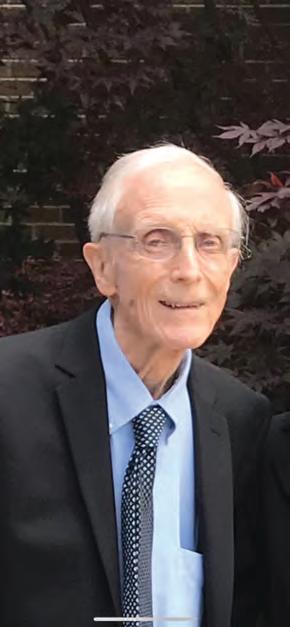
Since an engineering degree at Michigan State requires the most credits of any major – 128 –Pero said he tends to have more classes than his teammates.
“It’s manageable once you organize yourself, but I tend to have three classes a day and then practice right after and in between,” Pero said. “I’ve been an injured athlete for two to three years now, so a lot of time in the training room. Leaving in the morning and not getting home until after practice is normally what it is.”
Pero said labs as an engineering major are also lengthy, which adds to his already packed schedule. When Pero was injured, it was difficult to stand the entire time.
Like Wickes and Pero, applied engineering sciences junior and baseball player Bryan Broecker said his interest in math and science led him to a STEM major.
“I love the problem-solving of engineering, but I wasn’t quite sure that engineering was the best option for me,” Broecker said. “Applied engineering, which a lot of people call AES, is in the College of Engineering, but there’s a lot more business to it … so I get a little bit of the best of both worlds.”
Kinesiology junior and baseball player Trent Farquhar said he originally planned to major in physical education and health but ultimately landed on kinesiology.
“There’s a lot of nutrition facts and obviously
anatomy and physiology of how the body works,” Farquhar said. “Understanding my body as I’m out here playing is really cool to me.”
Over the years, Farquhar said he’s learned to manage his schedule by utilizing his free time to do school work, which includes any time he has before practice. Working ahead helps him prevent procrastination and stress, especially after long, tiring practices.
ADVICE FOR OTHER STUDENTATHLETES STUDYING STEM
Pero said organization, communication and planning his day out have helped him manage his schedule throughout his college career. His advice to student-athletes in STEM is to “accept the challenge.”
“It can seem a little overwhelming at times, but you just got to hang in there, more or less,” Broecker said. “Just try and plan out your days
and see what you’re doing. Stay on top of your homework and you’ll get through it.”
Farquhar said it’s important for studentathletes to pick a major they enjoy, especially if it’s in STEM.
“You’re in this for a reason and you hopefully like it, and you enjoy it,” Farquhar said. “If you’re enjoying STEM, it’s going to make it a lot easier and you can make the workload a lot less.”


Wickes said she advises other student-athletes, specifically those studying STEM, to stick with it even when it gets tough, and to lean on a support system.
“It’s not easy … it’s going to be hard, but … don’t give up,” Wickes said. “There’s going to be some really, really hard times and really hard moments, but sticking through it, relying on your teammates and the people around you to get through those – it’s going to be worth it in the end.”
Sophomore second baseman Trent Farquhar, left, and redshirt freshman Bryan Broecker, right, compare notes after practice on Thursday, Sept. 22 at McLane Stadium. Photo illustration by Chloe Trofatter
SPORTS 7STATENEWS.COMTUESDAY, SEPTEMBER 27, 2022
‘It’s not easy’:
OBITUARY NEWS FOR SPARTANS BY SPARTANS statenews.com @thesnews @thesnews@statenews The State News@statenews STAY IN THE KNOW Sign up for our newsletter!

TUESDAY, SEPTEMBER 27, 2022THE STATE NEWS8
